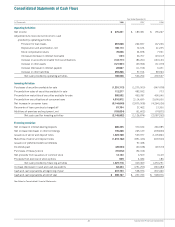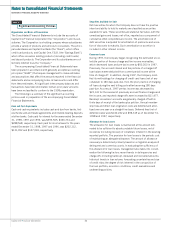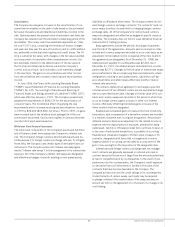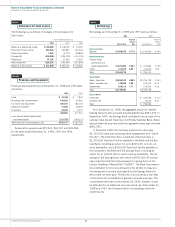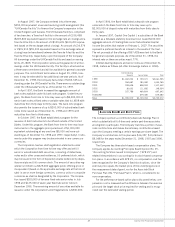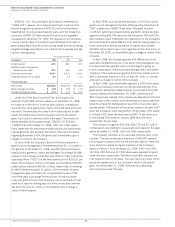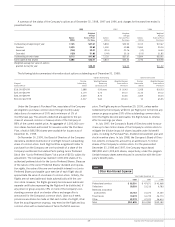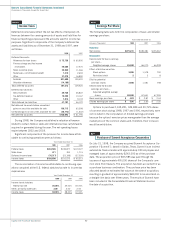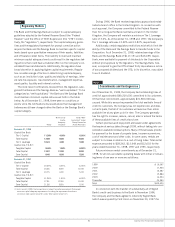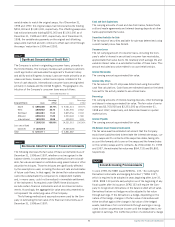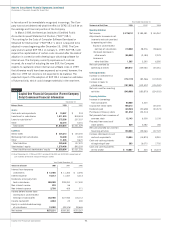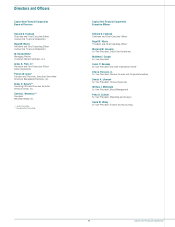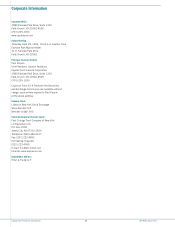Capital One 1998 Annual Report Download - page 53
Download and view the complete annual report
Please find page 53 of the 1998 Capital One annual report below. You can navigate through the pages in the report by either clicking on the pages listed below, or by using the keyword search tool below to find specific information within the annual report.
51 Capital One Financial Corporation
During 1996, the Bank received regulatory approval and estab-
lished a branch office in the United Kingdom. In connection with
such approval, the Company committed to the Federal Reserve
that, for so long as the Bank maintains a branch in the United
Kingdom, the Company will maintain a minimum Tier 1 Leverage
ratio of 3.0%. As of December 31, 1998 and 1997, the Company’s
Tier 1 Leverage ratio was 13.49% and 13.83%, respectively.
Additionally, certain regulatory restrictions exist which limit the
ability of the Bank and the Savings Bank to transfer funds to the
Corporation. As of December 31, 1998, retained earnings of the
Bank and the Savings Bank of $117,191 and $16,189, respec-
tively, were available for payment of dividends to the Corporation
without prior approval by the regulators. The Savings Bank, how-
ever, is required to give the OTS at least thirty days advance notice
of any proposed dividend and the OTS, in its discretion, may object
to such dividend.
Note L
Commitments and Contingencies
As of December 31, 1998, the Company had outstanding lines of
credit of approximately $49,200,000 committed to its customers.
Of that total commitment, approximately $31,800,000 was
unused. While this amount represented the total available lines of
credit to customers, the Company has not experienced, and does
not anticipate, that all of its customers will exercise their entire
available line at any given point in time. The Company generally
has the right to increase, reduce, cancel, alter or amend the terms
of these available lines of credit at any time.
Certain premises and equipment are leased under agreements
that expire at various dates through 2008, without taking into con-
sideration available renewal options. Many of these leases provide
for payment by the lessee of property taxes, insurance premiums,
cost of maintenance and other costs. In some cases, rentals are
subject to increase in relation to a cost of living index. Total rental
expense amounted to $18,242, $13,644 and $12,603 for the
years ended December 31, 1998, 1997 and 1996, respectively.
Future minimum rental commitments as of December 31,
1998, for all non-cancelable operating leases with initial or remain-
ing terms of one year or more are as follows:
1999 $ 19,097
2000 17,943
2001 16,687
2002 15,884
2003 14,934
Thereafter 24,980
Total $109,525
In connection with the transfer of substantially all of Signet
Bank’s credit card business to the Bank in November 1994,
the Company and the Bank agreed to indemnify Signet Bank
(which was acquired by First Union on November 30, 1997) for
Note K
Regulatory Matters
The Bank and the Savings Bank are subject to capital adequacy
guidelines adopted by the Federal Reserve Board (the “Federal
Reserve”) and the Office of Thrift Supervision (the “OTS”) (collec-
tively, the “regulators”), respectively. The capital adequacy guide-
lines and the regulatory framework for prompt corrective action
require the Bank and the Savings Bank to maintain specific capital
levels based upon quantitative measures of their assets, liabilities
and off-balance sheet items. The inability to meet and maintain
minimum capital adequacy levels could result in the regulators tak-
ing actions that could have a material effect on the Company’s con-
solidated financial statements. Additionally, the regulators have
broad discretion in applying higher capital requirements. Regula-
tors consider a range of factors in determining capital adequacy,
such as an institution’s size, quality and stability of earnings, inter-
est rate risk exposure, risk diversification, management expertise,
asset quality, liquidity and internal controls.
The most recent notifications received from the regulators cate-
gorized the Bank and the Savings Bank as “well-capitalized.” To be
categorized as “well-capitalized,” the Bank and the Savings Bank
must maintain minimum capital ratios as set forth in the table
below. As of December 31, 1998, there were no conditions or
events since the notifications discussed above that management
believes would have changed either the Bank or the Savings Bank’s
capital category.
Minimum for To Be “Well-
Capital Capitalized” Under
Adequacy Prompt Corrective
Ratios Purposes Action Provisions
December 31, 1998
Capital One Bank
Tier 1 Capital 11.38% 4.00% 6.00%
Total Capital 13.88 8.00 10.00
Tier 1 Leverage 10.24 4.00 5.00
Capital One, F.S.B.(1)
Tangible Capital 9.46% 1.50% 6.00%
Total Capital 13.87 12.00 10.00
Core Capital 9.46 8.00 5.00
December 31, 1997
Capital One Bank
Tier 1 Capital 10.49% 4.00% 6.00%
Total Capital 13.26 8.00 10.00
Tier 1 Leverage 10.75 4.00 5.00
Capital One, F.S.B.(1)
Tangible Capital 11.26% 1.50% 6.00%
Total Capital 17.91 12.00 10.00
Core Capital 11.26 8.00 5.00
(1) Until June 30, 1999, the Savings Bank is subject to capital requirements that exceed
minimum capital adequacy requirements, including the requirement to maintain
a minimum Core Capital ratio of 8% and a Total Capital ratio of 12%.


